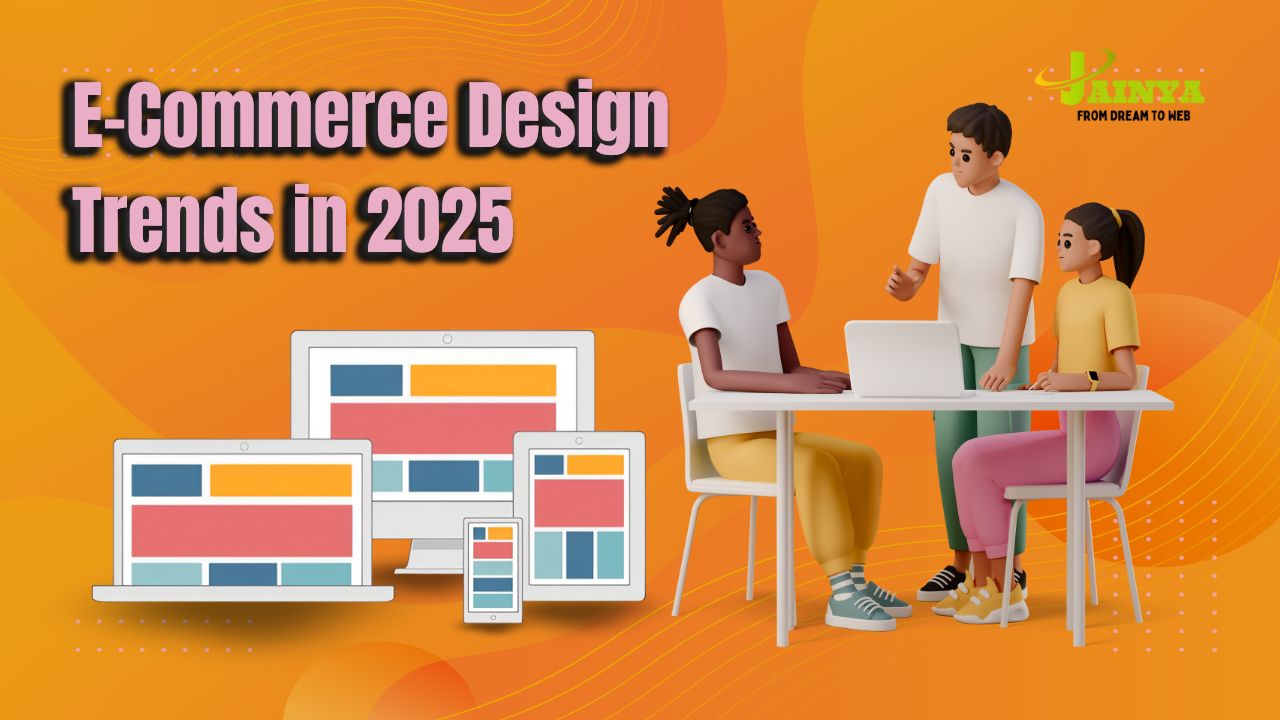Explore the latest E-Commerce Design Trends in 2025: Insights from Experts. Elevate user experience and boost sales with modern design strategies!

The world of e-commerce is evolving faster than ever, and staying ahead of design trends is no longer optional. Whether you’re a seasoned online store owner or a new entrepreneur, understanding the design shifts shaping 2025 can give you the competitive edge you’re craving.
So, grab your coffee (or tea!) and let’s dive into the modern design trends that experts say will define online shopping this year. Spoiler: It’s all about making life easier for your customers while looking fabulous doing it.
E-Commerce Design Trends for 2025: A Comprehensive Overview
| Trend/Feature | Description | Why It Matters in 2025 | Example Brands/Implementations |
|---|---|---|---|
| Seamless UI/UX | Focus on effortless navigation, sticky bars, intuitive filters, and fast load times | Reduces bounce rates, increases trust and conversions | Nike, Glossier |
| Micro-Interactions | Small animations or feedback (e.g., hover color changes, “ding” on add-to-cart) | Enhances engagement, makes the site feel modern and interactive | Nike (smooth animations), Glossier |
| Dark Mode Options | User-selectable dark color schemes for night-time or preference-based browsing | Reduces eye strain, appeals to night shoppers, shows user-centricity | Increasingly standard across platforms |
| Mobile-First Design | Sites designed primarily for mobile devices with thumb-friendly buttons and swipe features | Over 70% of shopping is mobile; essential for reach and conversions | Glossier (minimal, mobile-first) |
| Responsive Layouts | Adapts seamlessly to all screen sizes, from phones to tablets | Ensures consistent experience, prevents glitches | All leading brands |
| Mobile Payment Integration | Support for Apple Pay, Google Pay, and other mobile wallets | Meets user expectations for convenience and security | Most modern e-commerce sites |
| AI-Powered Personalization | Dynamic content and product recommendations based on user data | Boosts conversion rates by up to 30%, creates tailored experiences | Warby Parker (virtual try-on), Nike |
| Dynamic Content Optimization | Homepages and layouts adapt to user type (new vs. returning) | Increases relevance, drives engagement | AI-driven platforms |
| AI Chatbots & Assistants | Automated help and product discovery via conversational interfaces | Improves customer support, speeds up shopping | Warby Parker, Nike |
| Minimalist Aesthetics | Clean, uncluttered layouts that highlight products | Enhances focus, aligns with modern design sensibilities | Glossier |
| Interactive Product Pages | Features like 360° views, virtual try-on, and rich media | Builds confidence, reduces return rates | Warby Parker (virtual try-on), Nike |
Key Takeaways
- Seamlessness and speed are non-negotiable-customers expect effortless navigation and instant results.
- Mobile-first design is essential, with a focus on tailored, thumb-friendly experiences and mobile payment options.
- AI-driven personalization is transforming how sites engage and convert shoppers, from dynamic homepages to smart recommendations.
- Micro-interactions and dark mode add polish, delight, and accessibility, making your store feel modern and user-focused.
- Leading brands like Nike, Glossier, and Warby Parker set the standard by blending clean aesthetics, advanced tech, and customer-centric design.
The Importance of Seamless UI/UX in Modern E-Commerce Websites
Let’s face it, we’ve all clicked off a website because it felt clunky, outdated, or just plain confusing. In 2025, the buzzword for e-commerce design is seamlessness. Modern UI/UX features are all about creating an effortless shopping experience that keeps customers coming back for more.
Think sticky navigation bars, intuitive search filters, and lightning-fast load times. If your website doesn’t help users find what they need in seconds, they’ll probably move on to a competitor who does.
One trend experts can’t stop raving about is micro-interactions—those tiny animations or feedback signals that engage users without overwhelming them. For example, a subtle color change when a customer hovers over a product or a satisfying “ding” when an item is added to the cart.
These small details pack a big punch, making your store feel modern and polished while building trust with your audience. And trust me, in the e-commerce world, trust equals sales.
Another game-changer? Dark mode options. With so many people shopping late at night (hello, insomnia-driven retail therapy), dark mode is not just a nice-to-have—it’s a necessity. It’s easier on the eyes, looks incredibly stylish, and shows your customers you’re paying attention to their preferences.
Bottom line: If your UI and UX aren’t user-friendly and visually appealing, 2025 could be a tough year for your business.
Why Mobile-First Design Is Essential for Online Stores in 2025
If your e-commerce site isn’t mobile-friendly yet, this might sting a little: 2025 is all about mobile-first design, and ignoring it could mean missing out on a huge chunk of your audience. With over 70% of online shopping happening on mobile devices, it’s no surprise that experts are calling responsive design a non-negotiable. Your site should look stunning and work flawlessly, whether someone’s browsing on a 6-inch smartphone or a 12-inch tablet.
But mobile-first design isn’t just about shrinking your desktop site to fit a smaller screen. Oh no, we’re way past that. It’s about creating a tailored experience for mobile users—one that prioritizes speed, simplicity, and easy navigation. Features like thumb-friendly buttons, swipeable product carousels, and single-click checkouts are absolute musts. And don’t forget about mobile payment integrations like Apple Pay and Google Pay—they’re not just convenient, they’re expected.
Here’s a pro tip: Test your site on multiple devices regularly. What looks perfect on one phone might glitch on another. And remember, mobile-first design isn’t just for your customers—it’s for your bottom line too.
A smooth mobile experience means fewer abandoned carts and more happy shoppers clicking “buy now.” Trust me, your future self (and your bank account) will thank you.
AI-Driven Design Efficiency: Improving E-Commerce Website Performance

Artificial intelligence isn’t just for sci-fi movies anymore—it’s revolutionizing e-commerce design in ways you can’t ignore. In 2025, AI is the secret sauce that’s helping online stores create hyper-personalized shopping experiences.
From recommending products based on browsing history to tailoring homepage layouts to individual preferences, AI is making customers feel like your store was built just for them.
One of the coolest ways AI is being used? Dynamic content optimization. Imagine a homepage that changes depending on who’s visiting. A returning customer might see their favorite product categories front and center, while a new visitor gets a curated selection of bestsellers. This kind of personalization isn’t just fancy—it’s effective.
Studies show that tailored experiences can boost conversion rates by up to 30%. That’s a huge win for any e-commerce business.
But AI isn’t just about personalization—it’s also improving design efficiency. Tools like AI-driven chatbots and virtual shopping assistants are helping customers find answers and products faster than ever. And let’s not forget about AI-powered design tools that help you create stunning layouts without needing a professional designer. If you’re not already exploring AI for your website, now’s the time to start. It’s not the future—it’s the present.
Case Studies: Leading Brands Excelling with Modern E-Commerce Design
Sometimes, the best way to learn is by seeing who’s already crushing it—and there are plenty of brands leading the way in modern e-commerce design. Take Glossier, for example. Their minimalist, mobile-first website design is a masterclass in clean aesthetics and functionality. Every element, from the product pages to the checkout process, screams “user-friendly” while maintaining their signature brand vibe.
Another standout is Warby Parker, a company that’s seamlessly integrated AI into their online shopping experience. Their virtual try-on tool lets customers see how glasses will look on their faces, making it easy to shop with confidence. It’s the perfect blend of personalization and cutting-edge technology.
And who could forget Nike? Their e-commerce platform is dripping with modern UI/UX features, from interactive product pages to personalized recommendations. They’ve even nailed the art of micro-interactions, with smooth animations that make you want to explore every corner of their site. These brands are proof that investing in trendy, customer-focused design isn’t just about looking good—it’s about driving results.
E-commerce design in 2025 is all about putting your customers first while embracing the power of technology. With modern UI/UX features, mobile-first strategies, and AI-driven personalization, your online store can stand out in a sea of competitors.
So, what trend will you tackle first? Whatever you choose, remember: A well-designed website isn’t just an expense—it’s an investment in your business’s future.
Key Design Elements for a Mobile-Friendly E-Commerce Experience
As mobile shopping continues to dominate in 2025, having a mobile-friendly design is no longer just a trend—it’s a necessity. Mobile devices account for over 70% of online shopping traffic, making it crucial for e-commerce stores to deliver an optimized mobile experience. To achieve this, several key design elements must be prioritized:
- Thumb-Friendly Navigation: Mobile users interact with websites using their thumbs, so it’s essential to design interfaces that accommodate this. Large, easy-to-tap buttons and a well-organized navigation menu are key to ensuring a smooth browsing experience.
- Responsive Layouts: A mobile-friendly site should adapt seamlessly to various screen sizes, from smartphones to tablets. Responsive design ensures that images, text, and interactive elements resize appropriately, preventing any glitches or awkward scrolling.
- Fast Load Times: Mobile users are on-the-go and expect websites to load quickly. Compress images, streamline code, and use efficient caching strategies to ensure your mobile site is fast. Slow load times are a major turnoff and can lead to high bounce rates.
- Mobile-First Design: Instead of shrinking down the desktop version of a website, design with mobile users in mind first. Prioritize content and functionality that are critical on mobile devices, such as simple, intuitive interfaces and mobile payment integrations (e.g., Apple Pay, Google Pay).
- Simplified Checkout Process: Mobile screens have limited space, so it’s crucial to simplify the checkout process. Offer features like one-click payments, auto-fill forms, and guest checkout options to reduce friction and streamline the purchase journey.
- Optimized Product Pages: Ensure that product images are clear, zoomable, and fit the screen. Provide concise, easy-to-read product descriptions and make the add-to-cart button prominent. Mobile users should have everything they need at their fingertips without excessive scrolling.
By implementing these mobile-first design principles, your e-commerce store can deliver an optimal shopping experience that keeps customers engaged and boosts conversion rates on mobile devices.
Why Speed and Seamlessness Are Critical for E-Commerce Success in 2025
In 2025, speed and seamless navigation aren’t just nice-to-haves for e-commerce—they’re essential. Customers now expect websites to load in milliseconds and for the shopping experience to feel fluid from start to finish. A delay of even a few seconds can lead to cart abandonment, lower customer satisfaction, and ultimately, lost sales. Studies show that a delay of just one second in page load time can reduce conversions by up to 7%. This is why optimizing site speed should be a top priority for online store owners.
Seamlessness goes hand in hand with speed. It refers to the smoothness of the entire shopping journey, from browsing to checkout. Websites with intuitive designs, easy-to-use filters, and quick navigation help reduce friction, keeping customers engaged. By offering fast load times and a flawless user experience, you not only enhance customer satisfaction but also improve your site’s SEO ranking, as search engines like Google favor fast, user-friendly sites.
Ultimately, a seamless and fast website builds trust. When a customer feels confident that they can easily navigate and complete their purchase without any hiccups, they’re more likely to return and recommend your store to others. For e-commerce businesses looking to thrive in 2025, investing in speed and seamlessness is no longer optional—it’s a competitive advantage.

Leave a Comment